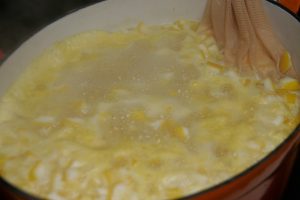
I’m always looking for jam and jelly recipes that don’t call for the addition of commercial pectin. Why? Because commercial pectin requires extra sugar to balance its bitterness and I’d just as soon keep my sugar consumption down (within reason!). With marmalades, the citrus pith and seeds give you all the natural pectin you need to get a perfect jell. No worries about ending up with syrup or fruit cheese, just sweet, tart, spreadable marmalade…every time. And since Meyer lemons are pretty much my favorite citrus, Meyer lemon marmalade is pretty much my favorite marmalade.

1. The Pectin Bond
Use equal parts (by volume) lemons, water, and sugar, but don’t exceed six cups of chopped fruit. Why? When preserves are made in overly-large quantities, they may not jell. There’s a complicated balance between the amount of time it takes to thoroughly heat the fruit v. the amount of time the pectin bond survives high heat. Heating more than six cups of fruit may take so long that the pectin bonds break down.

2. Measure your Fruit
Cut 1/4 inch off the top and bottom of each Meyer lemon, then slice the fruit in half vertically. Cut each half into several segments, about 1/4 inch thick. Remove and save the seeds and central pith. Cut each segment into small pieces and measure your fruit. If you have more than six cups of fruit, make multiple batches of marmalade.

3. Soften the Fruit
Combine the chopped Meyer lemons with an equal amount of water in your jelly pan. Place seeds and pith in a jelly bag (or cheesecloth) and add this to the fruit, attaching the bag to the handle of the pan. Boil for 20 – 30 minutes, until the fruit is tender. Eat a piece to test for doneness; if it’s chewy…keep cooking!

4. Extract the Natural Pectin
Remove your jelly pan from the heat and remove the jelly bag of pith and seeds from the fruit. Set the bag aside until it’s cool enough to handle, then squeeze the bag to get the pectin, which will be creamy in texture. You’ll get about 2 Tbs.; stir this into the fruit mixture.

5. The Jelling Point
Add sugar (the same amount you used for water and fruit) and return the mixture to the boil. At 15 minutes start checking for doneness (although it may take as long as 25 minutes). Use whichever test you prefer: thermometer @ 220 F (at sea level; at altitude you’ll need to adjust), spoon test, dish in the freezer test. Being a compulsive control freak, I often do all three.

6. Enjoy the End Result
This batch made ten half-pints of the best marmalade I’ve ever had. There is no end to ways I enjoy it: stirred into oatmeal, dissolved into tea, spread on a scone, baked into a jam tart, spread between cake layers…
It’s better with Meyers. You can substitute regular lemons in this recipe and still get a perfect jell. But the color and flavor will lack that certain special something you only find in a Meyer.
Ellen, this cheered me in uncertain times! Cooking is such a fundamentally positive, affirming act and this post feels sunny and hopeful. Thank you. Let’s all get out our pots and pans!